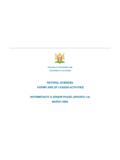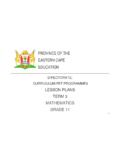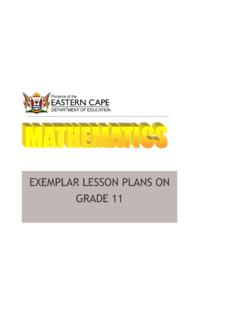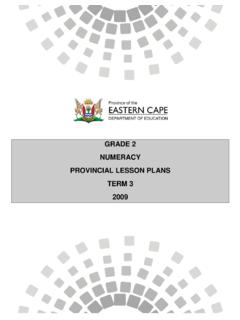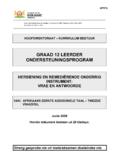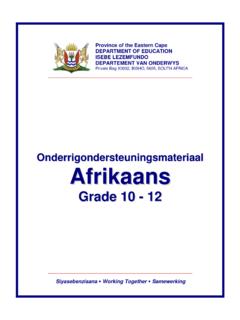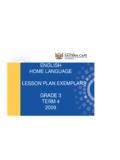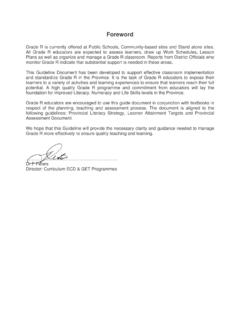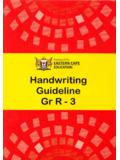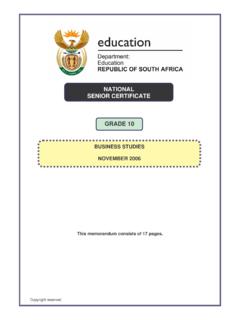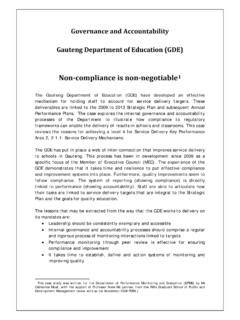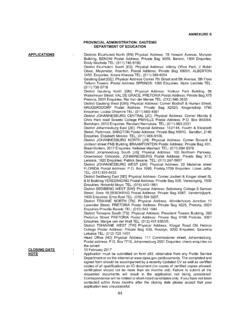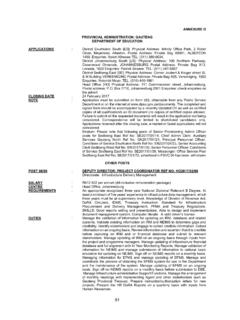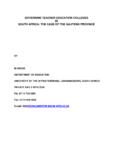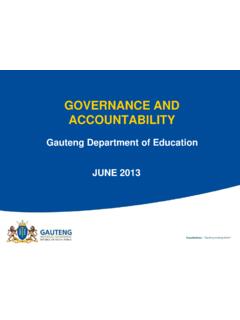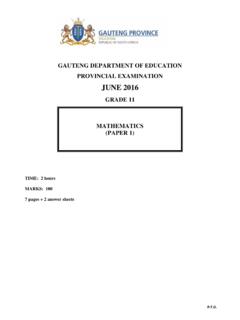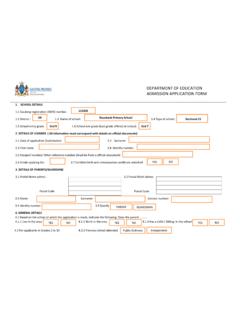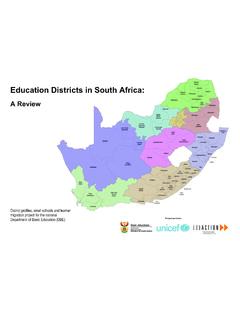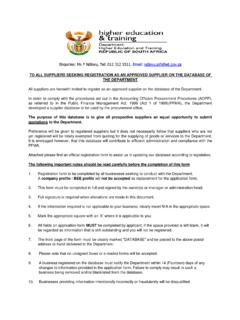Transcription of Province of the Eastern Cape DEPARTMENT OF …
1 1 Province of the Eastern Cape DEPARTMENT OF education ISEBE LEZEMFUNDO DEPARTMENT VAN ONDERWYS MATHEMATICS TERM 1 SENIOR PHASE lesson PLAN EXEMPLARS JUNE 2009 2 INTRODUCTION The Eastern Cape DEPARTMENT of education , Curriculum Chief Directorate in collaboration with the District curriculum personnel developed this document to support teachers planning, teaching and assessment for effective implementation of the National Curriculum Statement in the GET Band. The document contains exemplars of lesson plans with activities on each assessment standard in all learning outcomes. It is prepared with the intention to give necessary guidance for lesson planning for Term 1 in accordance with the provincial work schedule. This document must be used as a guide in collaboration with the following documents: National Curriculum Statement. NCS Teacher s Guide for the development of Learning Programmes, National Assessment Policy, Provincial Assessment Guidelines, Provincial Planning Document.
2 This can be adapted to suite the teacher s condition and contextual demands of the It is a guide to assist teachers in lesson planning. An exemplar is an illustration of how planning could be done, it is not cast on stone. Critical engagement with the document is encouraged. 3 NOTE TO THE TEACHER Ensure that Mathematics is taught daily for 1 Hour as according to policy. Daily classwork and homework should be given, marked and feedback be given to learners in order to ensure effective remedial work is done. Informal assessment tasks that culminate into Formal assessment tasks should be given at regular intervals. Consult as many text books as possible as well as other support material including internet, where possible when developing lessons. Please do not rely on one textbook only when planning lesson activities. Whenever possible, learners should be encouraged to get messy, in order to formulate their own meaningful concepts.
3 The teacher should assist learners in formalising their crude formulations as meaningful learning is the construction of the learner embedded in his previous experience .Learners misconceptions should be attended to before they become solidified. The teacher should challenge misconceptions with engaging discourse Some of the lesson plans encourage investigative approach to learning whenever possible. Activities in the lesson plan exemplars are a guide that helps to scaffold the teacher in developing other related activities. This guide is not cast on stone as context and other critical factors might have an influence. Critical engagement with the document is encouraged. 4 TABLE OF CONTENTS 1 INTRODUCTION 2 2 NOTE TO THE TEACHER 3 3 GRADE 7 Content Overview 5 lesson plan Exemplars 7 4 GRADE 8 Content Overview 32 lesson Plan Exemplars 34 5 GRADE 9 Content Overview 56 lesson Plan Exemplars 58 5 GRADE 7 MATHEMATICS lesson PLAN EXEMPLARS: CONTENT OVERVIEW TERM 1 TERM 2 TERM 3 TERM 4 LO1 Counting backwards and forwards in decimal intervals and integers Description and illustration of historical development of numbers ( integers, common fractions) Recognition, classification and representation of numbers (integers, decimals to at least 3 dec place) fractions and percentages in order to describe and compare them.
4 Factors including prime factors of 3 digit numbers Recognition and use of equivalent forms of rational numbers. Recognition, description and use of: equivalent fractions including common fractions, decimals and percentages LO2 Investigation and extension of numeric and geometric patterns to find relationships and to formulate rules, not limited to LO 1 Profit & loss, budgets, accounts, loans, simple interest, higher purchase, exchange rates, ratio and rates. LO2 Draw tables , flow diagrams to describe relationships, Look for pattern, describe in own words the relationship and make conjectures Mathematical Modelling in various context Problem solving LO3 Transformation (rotation, reflection, and translation) and symmetry to investigate properties of geometric figures Recognition and description of and differentiation between congruent and similar figures LO4 Calculations on perimeter, of LO1 Rounding off numbers to at least 1 decimal place.
5 Multiple operations with integers Addition, subtraction and multiplication of decimal fractions and common fractions. Division of positive decimals by whole numbers Percentages Exponents. Mental calculations involving squares to at least 122 and cubes to at least 53 LO2 Determination, analysis and interpretation of the equivalence of the same rule in different ways (verbally, in flow diagrams, in tables and by equations or expressions). LO3 Drawing and interpretation of LO1 Calculations using a range of techniques involving the commutative , associative and distributive properties with positive rational numbers and zero; also a calculator. Use of algorithms to find equivalent fractions LO 2 Description of a situation by interpreting graphs Drawing of graphs LO 3 Consolidation Drawing and interpretation of sketches of solids in different perspective. 6 sequences involving constant difference or ratio; ( In the natural and cultural contexts or learners own creation) Learners justify their conjectures LO3 Naming and exploring geometric shapes Similarities and differences between different polyhedra,and all quadrilaterals.
6 Classification of geometric figures and solids in terms of properties. Construction of geometric figures and designing of nets to make models LO4 Problem solving including : Time , distance, speed , length , Perimeter of polygons LO5 Selection and use of appropriate methods to collect data. Designing and using of questionnaires to collect data, record using tables and stem>and leaf displays Samples and populations various polygons Area of a square and surface area rectangle square triangle . Volume of the following right prisms: Triangular and Rectangular and cube LO 5 Determination and identification of measures of central tendency viz.: Median, mode, range and mean Drawing of graphs viz.: bar graphs histograms pie charts line and broken line graphs Critical reading and interpretation of data to draw conclusions and make predictions. sketches of solids in different perspective. Location of positions on co>ordinate systems and maps using Cartesian plane and compass directions LO 4 Interrelationship between perimeter, area, surface area and volume in geometric solids LO5 Theory of probability > listing possible outcomes and determine relative frequency.
7 Location of positions on co>ordinate systems and maps using compass direction LO4 Classification of different angles into acute, right, obtuse, straight, reflex and revolution Estimation, comparison, measurement and drawing of angles accurate to one degree using protractors. LO5 Consolidation: Theory of probability >listing possible outcomes and determine relative frequency 7 lesson PLAN EXEMPLARS GRADE 7 TERM 1 WEEK LOs & ASs CONTENT ACTIVITIES 1>3 Counts backwards and forwards in the following ways: In decimal intervals in integers for any intervals. Describes and illustrates the historical and cultural development of numbers ( integers, common fractions ) Recognises , classifies and represents the following numbers in order to describe and compare them: integers decimals (to at least three decimal places), fractions and percentages ; factors including prime factors of 3>digit whole numbers; numbers in exponential form including squares of natural numbers to at least 122, cubes of natural numbers to at least 53 , and their square and cube roots.
8 Recognises and uses equivalent forms of . Counting in: decimal intervals and integers Description and illustration of historical development of integers and common fractions Recognition, classification and representation of numbers integers, 3 dec place numbers, fractions and percentages, factors of 3digit whole numbers exponential form, square and cube roots in order to describe and compare them. Equivalent forms of common fractions, decimals and percentages Activity 1 Counting forwards and backwards Activity 2 Introduction of negative integers Activity 3 Recap on common fractions and equivalence between decimals, common fractions and percentage Activity 4 8 the rational numbers listed above ;including ; common fractions; decimals ; percentages . Activity 1 Teacher divides learners into groups Give different groups different work sheets(others counting forwards and others counting backwards in both whole numbers and decimals) Learners have to complete the following task : a) 0,90; 0,75 ; >>>;>>>;>>>.
9 B) 1,25; 1,10; >>>>; >>>> ;>>>. c) 2,125; 2,155; >>> ;>>>; >>>. d) 6175;6300;;>>>; >>>; >>>. e) 43 400; 43 175; >>>; >>>;>>>. Exchange the worksheets among groups Activity 2 Introduce the idea of negative whole numbers by referring to concrete examples that learners are already familiar with , 9 Temperatures in very cold regions in South Africa and other parts of the world. Bank statements may reflect a negative balance if you owe the bank money. It may refer to how deep a ditch is below the surface of the ground . Learners are prompted to give more examples. Learners give the first five elements of the following sets : i) Natural numbers ii) Counting numbers iii) Negative whole numbers The teacher explains that negative whole numbers together with the counting numbers form a set of Integers. Represent the integers as an Infinite set : Z= {.. >3; >2 ; >1; 0; +1; =2 ; +3; ..} Represent the set of integers on a number line.
10 Note: It is a good idea to view the number line in a vertical position initially so that the idea of order may easily be explained. (As an object moves up the line , the height of the object becomes greater) In the horizontal position numbers become larger as we move to the right and smaller as we move to the left. Activities should include the following types of questions : a) Indicate the position of the following numbers on the number line : 7; >12; 0 ; >8. 10 b) Arrange in order of increasing size : >56; 45; 0; 11; >28 c) Use the > and < signs to show which of the following is bigger or smaller than : i) >5 ..5 ii) >7 .. >8 iii) 0 .. >6 Activity 3 Revise the concept of common fractions as a part of the whole a loaf divided into four equal parts each part is a quarter. Extend to other examples within the same approach : 1/3; 1/8; 2/5; .. These are also known as proper fractions Learners are guided to differentiate between proper and improper fractions , such as 4/7; 8/3.
